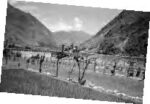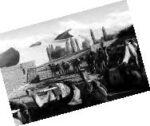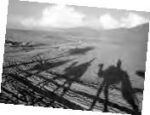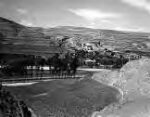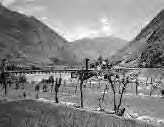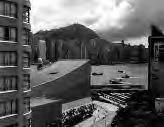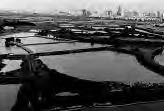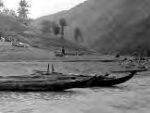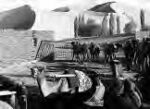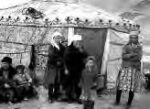China not only has the world’s largest population (over 1.3 billion), but it also is an extremely large country (more than 9.5 million square kilometers) with immense physical and cultural diversity. In fact, China should be viewed as an assemblage of pieces much like Europe. Anyone who tries to teach the geography of China faces the dilemma of either being very general (almost superficial) or delving into so many aspects and details as to be unable to complete the task in a single semester. How does one integrate three thousand years of history, language, local cultural practices, diets, architecture, et al. with basic physical geographies and economics that range from subsistence farming and herding to sophisticated electronics and computer industries in cities like Shanghai or Shenzhen?_________________________________________________________________________________________________________________________
To provide a sense of China’s diversity and its rich cultural fabric, one should probably divide the political unit into its natural parts, parts that are distinct both physically as well as culturally. Many of these “parts” have had a distinct cultural and political history as ancient kingdoms or states. Examples would include the ancient states of Shu and Ba in modern Sichuan, or of Nanzhao in modern Yunnan. In fact, each of the geographic regions discussed below at one time contained a distinct and separate culture, which over time have become melded into what is modern China. Still, these regions remain distinct in many respects.
But, one also should demonstrate the many ways in which China has been “united” and how many of its canals and rivers have been evolved and used to “unite” these many parts.
SOME USEFUL THEMES
Simply memorizing maps and map locations is not geography. Understanding the interaction between a natural environment and various human and cultural patterns is a major objective. These provide not only a “sense of place,” but they illustrate how people adapt differently in different environments. China is not one large homogeneous mass of people and behaviors. To fully appreciate its geographic and cultural diversity, one needs to follow some general themes that can act as a kind of guideline. Among the more useful themes in teaching and understanding the
diversity of China are:
Vernacular housing/shelter—how do people design their shelter to avoid climatic extremes and/or threats from invaders or neighbors?
Diets—What basic foods are available, and how do they reflect basic environmental conditions?
Economy—Given the natural environments, cultural preferences, and access to more distant markets, what kinds of economic activity other than self-sufficiency can evolve?
Cities—Cities in China have traditionally been centers of rule or control, not centers serving their economic hinterland. Thus, most cities have important strategic locations, and these should be “discovered” and discussed.
Regions—History and physical geography have often combined to generate distinct clusters of peoples and cultures. Often these have been “kingdoms” or “states” in the past.
REGIONALLY DISTINCTIVE CHARACTERISTICS
MAY GENERATE REGIONAL, CULTURAL AND ECONOMIC IDENTITIES
Everyone recognizes that any list of “typical” characteristics of a place will have many omissions and even overlaps with other places. Still, there are unique mixtures of foods, clothing, economics, etc. that give any region its own sense of place or flavor—a kind of cultural fingerprint—a method of distinguishing and understanding differences that are real, but often subtle. It is these distinctions that we seek to teach. It is important to understand that not all Chinese are alike or eat the same foods or talk the same way or even think the same. For example, some speak of the “Yellow River Valley” as a kind of uniform entity, despite its origins in the high Qinghai Plateau, passage through the arid loess plateau and gorges of Shaanxi, and finally across the open plains of North China. It is the recognition of geographic diversity that is an important objective and achievement when teaching about the geography of China.
THE NORTH CHINA PLAIN
No geographic area so typifies the standard image or myth of China and the Chinese as the North China Plain. Here are found the people who form the image of stalwart farmers (peasants) living in closely packed villages and houses of mud or adobe, although today many of these traditional dwellings are being faced with fired brick. It is an area subject to the extreme heat and frequent droughts of summer or floods of spring. Life on the North China Plain is one of self-sufficiency and subsistence. And finally, the inhabitants of the plain have had to endure endless depredations by armies and bandits who swept across the area in search of food or other loot, but it is an environment of little surplus and no natural mineral or other wealth. It was a perfect environment for Christian missionaries, and later the Chinese Communists, to bring a message of hope to the often utterly destitute. Still, it also was referred to as the “good earth.”
Mud-based, single-story houses
Wheelbarrows and canal boats for transport
Windy winters with dust
Wheat-based diets (especially steamed bread)
Many small villages
Winter food emphasizes potatoes
THE LOESS PLATEAU
While not as familiar to Westerners as North or South China, the Loess Plateau is an area of great historic importance to the Chinese. Most recently, it was the site of the headquarters of Mao Zedong and the Chinese Communist Party just prior to their conquest of China in 1948. In ancient times, this region was the meeting zone between the nomadic herders of the Mongolian and Central Asian steppe and the more settled farming communities of what would become China. It was on the margins of the loess areas that the great trading cities and capitals of empire first formed—Xi’an or Chang’an being the best known. Because winters are harsh, water scarce, and trees even scarcer, traditional houses were caves cut into the friable loess. Today, some forty million people still live in underground (cave) housing. As with North China, it was an area in which poverty and banditry traditionally were endemic. Only the cities could become wealthy and then only via trade with areas outside the immediate region.
Cave houses or adobe construction
Highly eroded and gullied terrain
Wheat noodles and sour cabbage dominate the diet
Colorful paper-cut designs
Use of mules and horses in transport
THE SICHUAN BASIN
Among the Chinese it often is said that “Sichuan is the first province to declare independence and the last to be reunited after there is peace.” Nothing so well illustrates the ability of Sichuan to be wholly autarchical—self-sufficient from the rest of China—as this comment and its reality. In dramatic contrast to North China or the Loess region, Sichuan is a province and region that can produce virtually any product grown anyplace in China. It has sufficient surplus so that it has no need for imports of foods or even raw materials. It truly is a land of independence—and its politicians (including Deng Xiaoping) and warlords have often behaved that way. Its climate generally is mild, and its location provides access to every major economic and physical environment in China—Tibet, the Loess Plateau, the Yangzi Valley, and the Southeast uplands. What it lacks is easy and secure access to the sea—but then does it really need this?
An interior basin of vast variety in climates and foods—from tropical to cold mountains
A high living standard and densely populated
Houses cling to sloped land, leaving flat land for food production
Gateway to Tibet and mixed ethnic groups, especially in the Chengdu Plain
Teahouses for social gatherings and gossip reflect free time from agriculture
THE SOUTHEAST COAST AND SHANGHAI
This region currently (1990s) is the area of the most active economic growth and development in China. It also was the region to first experience Western impact via the Opium War and “Treaty Ports.” It is an area with historically the greatest number of Christian missionaries, Chinese Christians, and Christian churches. And, like so many distinct physical environments in China, it is dominated by ethnic peoples not fully identifiable as “Han” who speak distinct languages and who often have closer ties to Chinese overseas than to those in Beijing.
Ocean fishing and commerce
Ocean ports and trade
Seafoods and tropical fruits dominate diets
Teas are a regional specialty crop
Houses are of brick with elaborate tiled roofs, often with large gardens
Wealthy merchants construct massive public buildings, bridges, etc.
THE YANGZI
(CHANGJIANG VALLEY)
Separated from other regions by mountains and extensive wetlands, the Yangzi (Yangtze or Changjiang “long river”), its tributaries and lakes are the focus of life and economics. Fishing and commerce by boat dominate life and culture. Cities, such as Chongqing (in Sichuan province), Wuhan and Nanjing are dominated by economies tied to waterborne transportation and commerce—not agriculture or even food processing. Major manufacturing centers exist along the river because of its cheap transport. There are large numbers of people who live their entire lives on small and medium-sized boats. They are “boat people” and make a living moving goods and people via the numerous lakes, canals and rivers of the entire Yangzi valley, especially in the areas around Shanghai. Contiguous to the river and dependent upon it for their cultures and economic well-being are the lake districts and provinces such as Hubei, Hunan, Jiangxi, Anhui, Jiangsu and Zhejiang.
Yangzi, Han, Xiang and Gan rivers
Chao Hu, Dongting and Poyang lakes
Rice and fish are dietary mainstays
Traditionally, people lived aboard boats
White plastered multistoried houses with black tiled roofs
XINJIANG
Contrasted with eastern China, Xinjiang is a landscape of deserts, mountains, and oases. Located between the cultural empires of China in the east and Persia and Central Asia in the west, Xinjiang was an important historic link. One result of this intermediate position is that Xinjiang’s people are predominantly Moslem and Turkic in ethnicity and language. Because of their proximity to Persia, their agricultural history is more closely linked to the mercantile cities and trade of the ancient Silk Road than the irrigation practices of eastern China. The trade and traffic along this famous route mixed people and cultures and introduced distinctive styles of music and musical instruments, especially the suona and pipa, or Chinese-style lute.
In the northern part of Xinjiang, the Junggar Basin, people have a long association with various Mongol peoples, and because this area has more moisture and grass than the Tarim Basin in the south, they are more pastoral than nomadic. The Tarim Basin was more closely related to Persia and the Islamic influences of the Middle East. It also was a traditional link (via the Silk Road) between Persia and the Middle East and eastern China. The Tarim Basin is characterized by city-dominated oases and mixed farming and animals (mostly sheep). In the Tian Shan (mountains that divide the two basins), the people are nomadic.
Earth/adobe houses
Central Asian or Persian-style architecture
Wheat noodles and flat, round wheat bread (nan) with mutton dominate the diet
Sheep, goats, camels and horses
Extensive areas of sand dunes
High alpine mountains
Common transport is by camel or long-distance bus and trucks
NORTHEAST (MANCHURIA)
As with Xinjiang and Tibet/Qinghai, Northeast China is one of the least typical environments compared to most of what is viewed as China in the popular mind. Winters are damp and cold. The best agricultural crops are commercial crops such as soybeans and sugar beets. Ice festivals mark winter holidays. Where the forests remain abundant, houses are built of wood and resemble housing in Russia’s Siberia. Regionally, diets are much richer in animal proteins and soybeans than in the rice and vegetables of central or southern China. Because of its rich coal and iron resources, the region was industrially developed by the Russians and Japanese, so it has more railroads and heavy industrial manufacturing than any other region in China. Perhaps a fitting analogy would be Germany’s Ruhr Valley or the Pittsburgh area of the U.S.
Industry and heavy manufacturing
Commercial agriculture (sugar beets, soybeans)
Railroads and superhighways for transportation
Russian-style architecture
Diets are dominated by meat and soybean curds
TIBET AND QINGHAI
Best known as the home of the Dalai Lama and the Tibetan (Yellow Hat) form of Buddhism, the Tibetan and Qinghai plateaus are extremely high in elevation (an average of 4,000 meters (14,000 feet). They also have a very sparse population for an area of about 2 million square kilometers and a combined population of only 6.5 million. Most of these people are concentrated in only two or three cities. Other than in the more verdant areas of the south face of the Himalayas and the subtropical mountains along the Sichuan border, the region is dominated by vast expanses of flat terrain dotted with lakes—most of which are saline. It is a harsh environment, not well suited to human use, and certainly not to crop agriculture.
Typical shelters for the nomadic herders are felt tents during the summer and low mud and dung huts or rock shelters for the winter. The cities are dominated by monasteries and their unique inward slanting, extremely thick walls and small windows.
Diets are dominated by yak butter (for fat and vitamins) and toasted barley. There are few green vegetables, and meat is a staple. A major limit on food availability is the high altitude that allows water to boil at very low (non-cooking) temperatures. This makes cooking meat extremely difficult without some kind of pressure cooker.
Tibetan Buddhism and monasteries
Herding peoples (sheep and goats)
High altitude and cold, even in the summer
Clothing is woolen and sheepskin layered
People travel by horse or walk
Long-distance travel is by truck
SOUTHWEST UPLANDS
Southwest China is a landscape of dissected plateaus, dense forests, and great ethnic diversity. This is one of China’s most inaccessible regions and thus one of its more economically backward as well. The hilly terrain makes bicycle traffic almost impossible, and most people travel by foot, water or horse. Hillsides were largely denuded during the Cultural Revolution (1966–76) but have been replanted—mostly with eucalyptus trees imported from Australia. In the south, near the border with Vietnam, are important tin mines originally developed commercially by the French. Plans for the 2000s are to develop close economic ties with Myanmar, Laos, and Thailand—a plan already well underway.
Diets are dominated by vegetables, rice, and ducks or geese
Houses may have thatched roofs and typically are built of wood or bamboo
Rolling hills, rugged valleys and mountains
Cormorant fishing from bamboo rafts
Thatched huts on stilts in the south
Rice, fish, fruits, and greens as diet mainstays
Multistory wood and stone houses in the north and west
Local transport is by foot, boat or horse
Tin mines are regional resources
Clothing is brightly colored, and silver jewelry is common
The linguistic and ethnic ties between these peoples, however, imply a future integration in the development of trade with Southeast Asia as well as growing economic independence of Beijing and North China.
TYING IT ALL TOGETHER—FROM EMPIRE TO STATE
Clearly, to create political “China,” it was and is important to tie these different “pieces” (regions) together. Transportation was, and remains, the most crucial factor. As the means of tying the country and its regions together proceeded, a common language and shared cultural values followed. Together they created an empire that was both political and cultural. Unlike the Roman Empire, the Chinese Empire evolved and has demonstrated an uninterrupted cultural and political history.
IMPERIAL HIGHWAYS
Because the origins of its empire lay in the interior of China—especially Xi’an—roads were initially more important than rivers and canals. Roads, of which the Silk Road is only one, but the best known to non-Chinese, not only followed the oases and core areas of historic China, they also clung to cliff faces by trestles when it was necessary to cross steep mountains such as the Daba and Qinling (e.g. the Shu Dao that linked the Wei valley with the Sichuan Basin).
THE GRAND CANAL
Much earlier, but clearly of national importance by Song times (960–1279) Chinese engineers took advantage of natural lakes and waterways, as well as a major crustal fault in the wetlands
between the Yangzi and the Huang Ho, and built a man-made canal linking the lower Yangzi Valley and Hangzhou. Its first “port” was Kaifeng (the Song capital) on the Yellow River; later it went to Beijing (the current national capital) in the far north.
LAKES AND RIVERS
Central China and the Yangzi River region are well served by the river as well as its major tributaries and their lakes. Thus, water and “boat people” are the dominant common tie and links for this region. As in the “three gorges” of the Yangzi and Daning rivers, where the river no longer was usable, there were trestle roads.
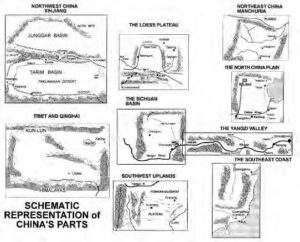 Clearly, every major region was united in part because of easy connections within its boundaries, but to create an empire or modern state transportation was, and remains, the key factor. Today, it is the railways and new highways that remain the physical manifestations of these “links.” However, one cannot underestimate the importance of television and telephones as well as the airlines in keeping the Chinese viewing themselves as one people and culture. Their value in political control was demonstrated in 1989 when televised “wanted” posters were broadcast instantaneously across all China, and in June of 1997 when the return of Hong Kong became a national rallying point—again, across all of China and at the same time.
Clearly, every major region was united in part because of easy connections within its boundaries, but to create an empire or modern state transportation was, and remains, the key factor. Today, it is the railways and new highways that remain the physical manifestations of these “links.” However, one cannot underestimate the importance of television and telephones as well as the airlines in keeping the Chinese viewing themselves as one people and culture. Their value in political control was demonstrated in 1989 when televised “wanted” posters were broadcast instantaneously across all China, and in June of 1997 when the return of Hong Kong became a national rallying point—again, across all of China and at the same time.
POLITICAL ORGANIZATION
As important as physical means of transportation and communication in creating a common culture has been political organization. No empire or state can exist without both cooperation and means of enforcing order among such disparate geographic areas and peoples. This was the primary achievement of the first “emperor of China,” Qin Shihuangdi, in 221 B.C.E. This first emperor defined the empire’s borders with Central Asia and established common laws for everyone in every geographic sector of the country. In modern times, the reunification of China’s geographic regions (often historically independent kingdoms or “states”) under a common Communist ideology was a major achievement of the Chinese Communists and the People’s Liberation Army.
Political organization in China has been successful in part because it recognizes the distinctiveness of various geographic areas. Today, large cities such as Shanghai, Beijing, Tianjin, Chongqing, and Hong Kong have special political status. Likewise, key economic cities have been created and given special political status to provide controlled access to modern economics and world trade. Finally, geographic areas dominated by non-Han Chinese cultures and peoples, such as Xinjiang, Ningxia, Tibet, Inner Mongolia, and Guangxi have been given political status (at least on paper) of being “Autonomous Regions.” Even at the local level, it is common to find special status given to cities or even geographic areas that require some kind of special political status to maintain political peace and order—a kind of geopolitical “gerrymandering.”
Thus, the Chinese have themselves long recognized their distinct geographic regions. It seems only reasonable that we should teach about China with the same awareness and sensitivity to geographic diversity.




